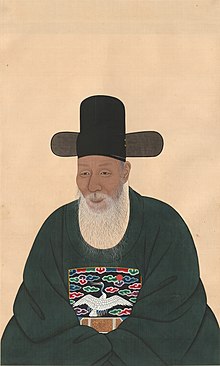Kim Jang-saeng
| Kim Jang-saeng | |
 |
|
| Korean name | |
|---|---|
| Hangul | 김장생 |
| Hanja | |
| Revised Romanization | Gim Jang-saeng |
| McCune–Reischauer | Kim Chang-saeng |
| Pen name | |
| Hangul | 사계 |
| Hanja | |
| Revised Romanization | Sagye |
| McCune–Reischauer | Sagye |
| Courtesy name | |
| Hangul | 희원, 희지 |
| Hanja | , |
| Revised Romanization | Huiwon, Huiji |
| McCune–Reischauer | Hŭiwŏn, Huiji |
| Posthumous name | |
| Hangul | 문원 |
| Hanja | |
| Revised Romanization | Munwon |
| McCune–Reischauer | Munwŏn |
| Clan Origin | |
| Hangul | 광산 |
| Hanja | |
| Revised Romanization | Gwangsan |
| McCune–Reischauer | Kwangsan |
Kim Jang-saeng (July 8, 1548 - August 3, 1631) was a Neo-Confucian scholar, politician, educator, and writer of Korea's Joseon period. He was the son of Kim Gye-hui (김계휘, 金繼輝), who was the Censor-General during the reign of King Seonjo and his mother was from the Pyeongsan Shin clan (평산신씨, 平山申氏), the daughter of Shin Yeong (신영, 申瑛). He's one of the famous members of the Gwangsan Kim clan and he was put in the Confucian shrine where he was honored as a Munmyo Bae-hyang (문묘배향) sage-scholar. Thus, he became one of the 18 sages of Korea (동방 18 현).
He was successor to the Neo-Confucian academic tradition of Yulgok Yi I (이이) and Seong Hon (성혼).
Kim Jang-saeng was the father of Kim Jip, an eminent Neo-Confucian scholar of the Joseon dynasty, and great grandfather of Kim Manjung, the author of Guunmong (The Cloud Dream of the Nine) and Sasinam jungi.
...
Wikipedia
